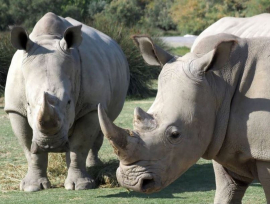
Government is working around the clock to fight wildlife crime and corruption, especially in the Kruger National Park, says Forestry, Fisheries and the Environment Minister, Barbara Creecy.
Citing the recent study published by ENACT Africa on corruption and criminality in the Kruger, she announced that the National Integrated Strategy to Combat Wildlife Crime was adopted by Cabinet last week.
This means the National Joint Operational and Intelligence Structure (NATJOINTS) Priority Committee on Wildlife Trafficking will now identify critical measures by all government agencies that can be implemented over the next six months.
According to reports, the probe found the internal corruption, breakdown of trust and staff cohesion plus worsening organised crime in Mpumalanga to be of greater threat to the future of the park than poaching.
“In the Kruger Park itself, we are focusing on improving the wellness and well-being of our staff so that they are not lured into the illicit trade,” she told Members of Parliament.
Measures include career path development and training; ranger wellness and counselling programmes; improvements in staff housing and putting in place an anonymous tip-off line and setting up liaison committees with local communities.
In addition, she said the Tourism Business Council of South Africa has installed hi-tech surveillance equipment at the Numbi Gate.
Meanwhile, the Kruger Lowveld Chamber of Business and Tourism is supporting a community training and development initiative to improve security around this access point.
The Minister was speaking during the Department of Forestry, Fisheries and the Environment’s 2023/24 Budget Speech vote in Parliament.
In addition, she said the department will this year support Ezemvelo KZN Wildlife to fight rhino poaching and related wildlife crimes.
The department said it will also contribute R40 million to improve the boundary fencing.
SANParks
Creecy said South African National Parks (SANParks) remains the international benchmark for conservation management in South Africa.
As part of its commercialisation drive, SANParks aims to deliver 39 new tourism products over the next three years in partnership with the private sector, while 14 of these projects will open in this current financial year.
In addition, these programmes will provide economic opportunities to local communities by creating 2 209 direct jobs in local small and medium-sized enterprises (SMMEs) from goods and services valued at R75 million a year.
Fishing sector
Turning her attention to the fishing sector, Creecy said the sector is an important contributor to the economy and to the improvement of the lives of coastal communities.
In 2021, the department received 2 473 applications for the allocation of commercial fishing rights across nine fishing sectors, while fishing rights were allocated to 714 rights holders across nine fisheries in February 2022.
She said work was underway to complete 1 213 appeals against the decisions of the delegated authorities in the nine fishing sectors for the 2021/22 Fishing Rights Allocation Process (FRAP).
Meanwhile, Creecy announced a draft strategy and action plan to combat trade in illegally harvested abalone, which is currently in the consultation phase.
The department is also leading the process of developing Marine Sector Plans as part of the Marine Spatial Planning process.
“Users of our ocean include individuals, communities, fishers, and the mining sector. Ten drafts of Marine Sector Plans have been published for public comment with the aim of promoting the co-existence of different sectors.”
To manage competing interests in the marine environment, the department last year committed to researching the impact of seismic surveys on the marine environment.
“The department has produced an assessment of international best practice in mitigating impacts of these surveys and are now determining how these can be used on local ocean areas.
“We are also working with the Petroleum Agency of SA and the Council for Geo Science to map historic records of seismic surveys to determine if any impact was observed during these previous surveys,” she added. – SAnews.gov.za


